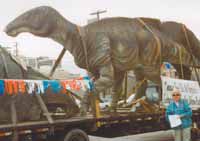| Carole Jones, of Castle Dale poses with the replica of the dinosaur she found. |
Eolambia Caroljonesae
That’s the name of one of the newest dinosaur additions to the George S. Eccles Dinosaur Park in Ogden. On the morning of April 14, the replicas of three of the newest dinosaur finds were trucked to the park for installation as permanent exhibits.
An Emery County resident had the privilege to watch her own namesake lowered into its place in the park. Carole Jones, of Castle Dale, has been hunting dinosaurs with her husband Ramal for many years. With the distinction of being the only couple in the world to both have dinosaurs named after them, the couple watched as Carole’s find was revealed.
During the 1990s, Ramal and Carole were very much into locating new species of dinosaurs. With a several million year gap to fill, they knew there had to be more out there. Together they went looking. Carole was the one who found the first bones to Eolambia Caroljonesae. Eolambia lived about 97 million years ago and was discovered in 199l in the upper Cedar Mountain Formation just east of Castle Dale.
Carole and Ramal notified Don Burge of the College of Eastern Utah, who came out and supervised the dig for the remainder of the skeleton. Later excavations included Bob and Annette Marquardt. Bob discovered the femur and other significant bones on a hill near the original dig site. Bob is the chairman of the development for the dinosaur park in Ogden.
James Kirkland named and described Eolambia Caroljonesae in 1998. He classified it as a Hadrosaur and a very important one. If Eolambia is a Hadrosaur, it is the oldest yet found. A few paleontologists have since argued that Eolambia is actually an Iguanodant, but most still believe Eolambia should be classified as the first Hadrosaur.
It is believed Eolambia’s ancestors were from Asia and that Eolambia was among the first dinosaurs to cross into North America through what is now Alaska. Eolambia was a herding, herbivorous dinosaur that probably migrated from shore lines to higher ground to reproduce. They were up to 30 feet in length.
Carole was at the Delta Center in Salt Lake City to watch the reproduction of her dinosaur roll in on the trailer of a semi. Salt Lake City and Ogden City police along with the Utah Highway Patrol, then escorted the procession to the Ogden City offices. After a short program and ribbon cutting, the procession proceeded to the park and museum, where crews awaited with cranes to unload and set into place the 12,000 pound replicas.
Carole’s dinosaur is a concrete, steel pipe and rebar reproduction that took six months to build. The bones that she found, and were later excavated, were used to study, identify and name this new member of the dinosaur world. These bones are in the College of Eastern Utah’s archives for future study.
Marquardt was the donor of the nearly $35,000 it cost to do the reproduction. Tom Prevatt was the artist that completed the reproductions.
Ramal has developed a process of radiological surveys that maps paleontolgical sites for dinosaur bones. The process locates buried fossilized dinosaur bones and is used to locate specific bone locations. The couple have traveled extensively mapping sites around the United States.
The couple is recognized around the world for their work with dinosaur study.

